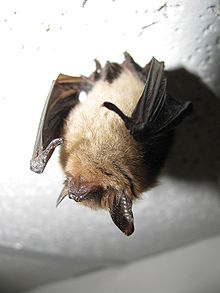- Northern long-eared myotis
-
Northern long-eared myotis 
Conservation status Scientific classification Kingdom: Animalia Phylum: Chordata Class: Mammalia Order: Chiroptera Family: Vespertilionidae Genus: Myotis Species: M. septentrionalis Binomial name Myotis septentrionalis
(Trouessart, 1897)The Northern long-eared myotis (Myotis septentrionalis) is a small bat, typically 5-10 g and 84 mm in total length [2]. The fur is dull brown on the dorsum and yellowish on the venter. Compared to other Myotis species, these bats have long ears with a relatively long tragus in each ear.
Contents
General habits
Females give birth to 1 pup each summer and often form large maternity colonies (30-60 individuals) consisting mainly of females and their young. In the fall, northern long-eared bats migrate to caves to hibernate. Migration distances are not known for this species. Northerns are often found roosting singly in caves, rather than in the large clusters typical of other Myotis species, like Myotis sodalis.
Foraging
Northern long-eared bats are well-suited to foraging in the forest interior. Echolocation calls have a classic frequency-modulated (FM) structure that allows these bats to navigate through cluttered environments. Further, their small size allows for more agility in dense vegetation. Long ears allow northerns to find even stationary insects. Northerns' diets are focused on moths (Lepidoptera), which they often capture by gleaning, or plucking, the insects from a surface. Gleaning is a unique foraging habit for insectivorous bats since many capture their prey in flight.
Distribution
This species is found primarily in coniferous forest from Newfoundland to the Yukon, and in the southeastern United States through to Florida. Specimens have been found as far west as British Columbia and Texas.
References
- ^ "Myotis septentrionalis". IUCN Red List of Threatened Species. Version 2009.2. International Union for Conservation of Nature. 2008. http://www.iucnredlist.org/apps/redlist/details/14201. Retrieved 08 February 2010.
- ^ Whitaker, J. O. and W. J. Hamilton, Jr. 1998. Mammals of the eastern United States. Comstock Publishing Associates, Cornell University Press, Ithaca, NY. 583 pp.

This Vespertilionidae article is a stub. You can help Wikipedia by expanding it.

